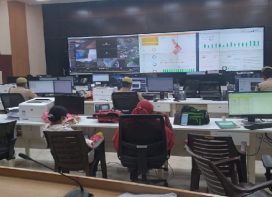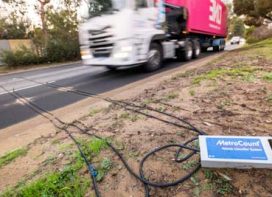 If you think that the much needed Smart Cards for driving licences and tracking road offences cannot become a reality in India, then we must tell you that this technology has already been developed by IIT Kanpur in 2001 itself. It is on this very technology that the Ministry for Road Transport and Highways’ much hyped ‘Vahan Sarathi’ programme is based. And if you want to know if such a Smart Card can tell about offences committed in other states and is operable pan India, then ask Rajat Moona, the Director General of C-DAC, Pune. As Vidyottama Sharma did. The answer: Yes, it can tell you of offences committed in other States. He should know, for his former team at IIT Kanpur is the brain behind this technology that is operable throughout the country. Which leads us to the next most important question: Then, what are we waiting for?
If you think that the much needed Smart Cards for driving licences and tracking road offences cannot become a reality in India, then we must tell you that this technology has already been developed by IIT Kanpur in 2001 itself. It is on this very technology that the Ministry for Road Transport and Highways’ much hyped ‘Vahan Sarathi’ programme is based. And if you want to know if such a Smart Card can tell about offences committed in other states and is operable pan India, then ask Rajat Moona, the Director General of C-DAC, Pune. As Vidyottama Sharma did. The answer: Yes, it can tell you of offences committed in other States. He should know, for his former team at IIT Kanpur is the brain behind this technology that is operable throughout the country. Which leads us to the next most important question: Then, what are we waiting for?
How did your team at IIT Kanpur (before you moved to C-DAC, Pune) get into developing the smart card technology for driving licences and road offences?
About ten years ago, many vendors were approaching the government offices at various places with the suggestion that driving licences must be based on a Smart Card that not only looks good but in which the loaded data cannot be tampered with. But the problem with this kind of an approach was that once a driving licence was issued, it had to be valid all over the country. You cannot have a driving licence issued in Gujarat that will not be understood in Maharashtra or issued in Maharashtra that will not be understood in Tamil Nadu. The approach had to be common.
So, at that point of time, the Ministry for Road Transport and Highways decided to set up an Expert Committee to look into this issue and propose a solution. Everybody was clear that since a smart card based licence would be non-tamperable, nobody could issue fake licences. However, its operations must be inter-operable across the country.
Who headed the Committee?
 The Committee was set up under the chairmanship of Dr B K Gairola of NIC who is now its Director General. The Committee then began talking to various vendors interested in the Smart Card business. It invited representatives of vendors, manufacturers and system integrators. It was very clear at that point of time that there had to be an initiative within the country because there was no existence of such system elsewhere which could be interoperable across the entire country.
The Committee was set up under the chairmanship of Dr B K Gairola of NIC who is now its Director General. The Committee then began talking to various vendors interested in the Smart Card business. It invited representatives of vendors, manufacturers and system integrators. It was very clear at that point of time that there had to be an initiative within the country because there was no existence of such system elsewhere which could be interoperable across the entire country.
Several vendors had done these kinds of projects in various other countries but they were small, like Singapore which is more like a city in India. It is much easy to do it there but the same solution would not work in India given its interoperability requirements. Here we need to incorporate many vendors, many system providers and many integrators within the system and they must all work in an interoperable manner.
It is possible to build the entire equal structure for smart cards today because you can actually read the cards with regular telephones, mobile phones, small gadgets, laptops, and in many other ways. Of course, you need to sensitise the RTO towards that kind of operations and involve the judiciary in reading that kind of smart cards because compounding of licence for every offence is the function of the judiciary.
So, how did you tackle that problem?
We developed this Smart Card based system ourselves in 2001 for driving licence and vehicle registration certificate in Kanpur along with NIC Delhi. We began with defining the standard of Smart Card operating system at that point of time. This standard was then adopted by the committee and subsequently by the Ministry of Road Transport & Highways. The Ministry notified this in 2001. Subsequently, another Committee of DIT (Department of Information Technology) opined that for all e-governance projects and Central Government projects, the standard we defined must be used for ID applications. We called this standard Scosta then.
What does Scosta stand for?
At that time the acronym stood for Smart Card OS for Transport Applications. In the OS, however, there was nothing really specific for transport. Scosta is a proper noun today. This particular standard was then used for issuing driving licences as well as vehicle registration certificates. NIC had a programme known as Vahan Sarathi. This Smart Card became an integral part of Vahan Sarathi. Today, driving licences are issued, and vehicle registrations are done, based on this smart card technology (Scosta and Vahan Sarathi) in Rajasthan, Maharashtra, Delhi and many other places.
Where else was this technology adopted?
Subsequently, it was also adopted as the National Standard. Prior to Aadhar (Unique Identification ID), there was a multipurpose national identity card project under the Registrar General of India which was being based on the same technology that we had defined. A pilot was done for about 20 lakh people in 2007-08.
 TrafficInfraTech Magazine Linking People Places & Progress
TrafficInfraTech Magazine Linking People Places & Progress


